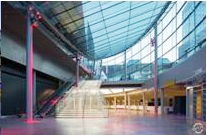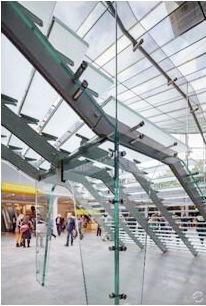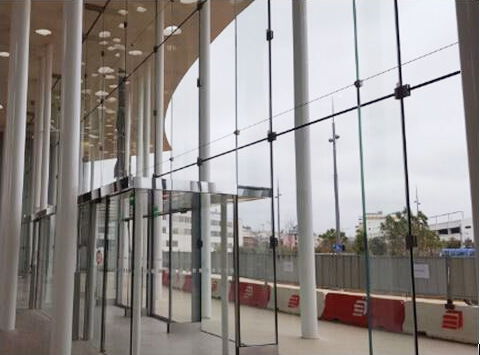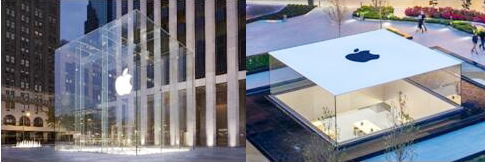Brief Introduction to Glass Structure Research and Engineering Practice.

Abstract: In recent years, structural glass that directly bears loads has become the latest trend in the application of architectural glass. This article reviews the important research progress in glass structural components and connection nodes at home and abroad, introduces several representative glass structural engineering applications at home and abroad, discusses the key issues currently existing in glass structure research, and looks forward to the focus of future research work, in order to provide a reference for scientific research and engineering technicians in the field of glass structure.
Keywords: glass structure; laminated glass; buckling; component design; node design
1. The introduction
Glass has been widely used in buildings for many years because of its characteristics of lighting, decoration, and durability. However, for a long time, the application of architectural glass has been mostly limited to secondary load-bearing components such as external enclosure components, and decorative components, such as doors, windows, curtain walls, etc. In recent years, with the improvement of glass processing technology and design technology and the needs of social and economic development, the application of glass in buildings is no longer limited to enclosure structures. Glass structures that directly bear loads have become the latest trend in the application of architectural glass. Some glass structural components such as glass beams and glass columns have appeared in actual projects. Some buildings are even built entirely of glass structures, such as most of Apple's stores around the world. Glass structure buildings are transparent, bright, and modern, and are loved by people. As a unique structural material, glass is increasingly valued by building owners and architects.
Since the late 20th century, foreign countries have put the research results in the field of glass structures into engineering practice and built a series of well-known landmark buildings. In 2010, the European Committee for Standardization issued the future compilation tasks of the European standards, planning to include glass structures in the European standards. In 2014, the Joint Research Center of the European Commission compiled the "European Glass Component Structural Design Guide" [1], which provides a general design method for glass structures and hopes to be included in the new European standards after trial and evaluation.
This article first reviews the important research progress in the field of glass structure in various countries, including the study of the mechanical properties of laminated glass under different in-plane and out-of-plane stress conditions, and the study of the force transmission mechanism of three nodes: mechanical connection, structural adhesive connection, and hybrid connection. It briefly introduces several representative glass structure engineering applications such as the new entrance hall of the Van Gogh Museum and the Apple flagship store, and discusses the key issues that need to be paid attention to in future glass structure research work, providing reference for glass curtain wall practitioners and engineering and technical personnel.
2. Research on glass structure
2.1 Component research
Since glass itself is a brittle material, in order to prevent glass components from suddenly breaking and fragments from falling and injuring people, glass structure components generally use laminated glass.
Foreign countries began to study the mechanical properties of laminated glass for construction no later than the 1970s [2]. So far, a relatively comprehensive study has been conducted on its basic mechanical properties such as bending, shearing, and compression. The study found the correlation between the mechanical properties of laminated glass and the shearing properties of the intermediate film, established an analytical model for laminated glass components under different mechanical forms, and proposed corresponding design methods. Wölfel [3] first proposed the concept of equivalent thickness in 1987, converting laminated glass into a single glass plate with an equivalent bending constant to analyze laminated glass subjected to out-of-plane loads. In recent years, Galuppi et al. [4][5] proposed an enhanced equivalent thickness method using the energy variation principle to analyze and design multi-layer laminated glass under different boundary and load conditions. Bedon, and Amadio [6] studied the in-plane shear buckling behavior of four-sided supported laminated glass plates based on the equivalent thickness method and numerical simulation parameter analysis. Amadio and Bedon[7][8][9] studied the influence of factors such as ambient temperature, loading duration, and initial defects on the bending and pressure-bearing properties of laminated glass based on the Newmark composite beam theory, and gave design recommendations. Machado-E-Costa et al.[10] proposed a calculation formula for the equivalent bending stiffness and torsional stiffness of multilayer laminated glass based on the "sandwich" model. Bedon, Belis, and Luible[11] compared the existing analysis methods of laminated glass based on experimental data, including the "sandwich" model, Newmark theory, and equivalent thickness method formula, and found that several calculation methods can obtain relatively accurate prediction values under given temperature and loading duration conditions. Bedon et al.[12][13] used numerical simulation to study the lateral-torsional buckling behavior of elastically constrained single-piece glass beams subjected to in-plane bending based on the elastically constrained lateral-torsional buckling theory of steel beams.
2.2 Connection study
Typical connection methods in glass structures generally include mechanical connection, structural adhesive connection, and hybrid connection that uses both. Among them, mechanical connection is generally achieved through bolts, which are divided into pressure-bearing bolt connection and friction-bearing bolt connection; structural adhesive bonding connection mainly uses structural adhesive to bond glass to other materials to form a connection node; hybrid connection node mainly combines the characteristics of mechanical connection and adhesive connection, and the metal parts and structural adhesive form a node area at the connection part.
At present, foreign scholars have conducted comprehensive research on several typical connection methods in glass structures. Baitinger, Feldmann[14],[15] studied the stress distribution of glass at the pressure-bearing bolt connection node based on the theory of elastic mechanics, and proposed a simplified design formula for the pressure-bearing bolt node. Bernard and Daudeville[16] studied the stress performance of friction-type bolt connections based on annealed glass and tempered glass and found that bolt torque and cushion friction coefficient have a significant effect on the stress distribution and failure mode of the node. Campione et al.[17] studied the stress performance of the node of laminated glass components connected by angle steel and bolts. The node can achieve a semi-rigid connection, but there is stress concentration near the bolt hole, which is prone to brittle failure. Beils et al. [18] studied the effects of temperature and gasket material on the friction bolt joints used to connect laminated glass components, compared the effects of various factors on the bolt preload, and explored the influence of these factors on the friction value at the joint. Machalická and Eliášová [19] studied the effects of different substrates, different types of structural adhesives, different adhesive layer thicknesses, different surface treatments, and aging effects on adhesive connections, and found that frosting the glass surface can improve the bonding strength, and the bonding strength decreases with the increase of adhesive layer thickness. Overend et al. [20] studied the mechanical properties of several structural adhesives such as silicone adhesive, polyurethane adhesive, epoxy adhesive, two-component acrylate adhesive, and UV-curing acrylate adhesive, including stiffness and strength. Santarsiero et al. [21][22] studied the tensile properties of two high-temperature adhesives (SGP, TSSA) and the shear properties of the joints of glass-stainless steel when considering temperature and strain rate, obtained the engineering stress-strain curves of the adhesives at different temperatures and strain rates, and gave the calculation formula for the shear bearing capacity of the joints. Carvalho et al. [23], Puller and Sobek [24], and Zangenberg et al. [25] studied the stress performance of metal-implanted hybrid connection nodes in laminated glass. The parameters studied included metal material type, bonding material type, temperature, loading rate, stress mode, etc.
3. Engineering practice of glass structures
Currently, structural glass is mainly used in floor slabs, roofs, walls, stairs, awnings, and other components of building construction, as well as facilities such as overpasses and sightseeing plank roads. There are also some all-glass structural buildings.
In the 1980s, foreign countries began to try the engineering application of glass structures, such as the load-bearing all-glass curtain wall structure built by Dutch Jan Benthem and Mels Crouwel in 1984. The two all-glass buildings designed by the architectural and glass designer group Santambrogio (Carlo Santambrogio and Ennio Arosic) in Milan, Italy (Figure 3.1) consist of T-section columns composed of glass ribs and glass panels. The glass beams and glass columns are connected by bolts to form a frame structure system. The glass stairs, glass coffee tables, glass cabinets, glass beds, etc. inside the building are all spliced by bolts.
(a)Three-layer frame glass frame
(b)Stilted glass house
Figure 3.1 All-glass building designed by Santambrogio
The new entrance hall of the Van Gogh Museum, which opened in 2015 (Figure 3.2), was completed by KishoKurokawa Architects, Hans van Heeswijk Architects and Octatube Structural Designers. It is currently the largest glass structure hall in the Netherlands. The structural design of the entrance hall is a hybrid structure consisting of a spherical glass roof, a cold-bent glass curtain wall, and a steel structure. The glass staircase is supported by a glass arch. The glass roof consists of insulating glass and laminated glass units of different sizes and is supported by SG multi-laminated glass ribs. The maximum stiffening rib is 12m long and 700mm high. The glass beam is bonded to the main steel frame to provide support for the glass roof. The curved curtain wall is composed of cold-bent insulated glass units, fixed by 20 different triple-layer glass stiffeners. The longest dimension of the stiffener is 9.4m, and the minimum bending radius of the curtain wall is 11.5m[26].
Figure 3.2 New entrance hall of the Van Gogh Museum
The facade of the Montpellier Medical School in France, designed and built by François Fontès in 2017, uses a glass curtain wall constrained by glass ribs (Figure 3.3). The maximum size of the glass panel is 3.8m*2.8m, and the glass rib is 12.71m high. Titanium metal implanted node connections are used to ensure the stability of the structure under lateral buckling and seismic loads[27].
Figure 3.3 The facade of the Montpellier Medical School in France
Apple has built a series of glass structures around the world (Figure 3.4). The entrance hall of the Apple flagship store on Fifth Avenue in New York, which opened in 2006, is a pure glass cube with a side length of 10m. It is jointly supported by multi-layered glass ribs and glass walls connected by metal implanted nodes. The Apple flagship store in Zorlu Center, Istanbul, Turkey, which opened in 2014, is equipped with a full glass wall load-bearing building, which is composed of four 10m wide and 3m high SGP multi-layer tempered glass connected by structural silicone adhesive. The Kunming Apple flagship store, which opened in 2017, is supported by eight groups of 5.4m high U-shaped SGP multi-layer glass columns, supporting a 20.9m diameter carbon fiber reinforced polymer roof. The Steve Jobs Theater in the Apple headquarters building in the United States, which opened in 2017, has a 47m diameter carbon fiber roof supported by a cylinder composed of 7m high curved glass panels. It is currently the largest glass support structure in the world. Considering the earthquake-resistant design, the glass panels are fixed in the steel grooves that transmit earthquake energy through structural silicone adhesive, so that the glass can adapt to the displacement caused by the earthquake, thereby ensuring the integrity and robustness of the overall structure [28].
Figure 3.4 Apple Flagship Store in New York, USA; Apple Flagship Store in Istanbul, Turkey
Figure 3.4 Apple Flagship Store in Kunming, China; Steve Jobs Theater at Apple Headquarters, USA
4. Outlook
In recent years, glass structure-related research has made many important progresses at home and abroad, and structural design methods have become increasingly rich and perfect. However, there are still many problems in the application of glass structure systems in engineering. In future research work, the following issues need to be paid attention to:
4.1 Technology for improving the bearing capacity and ductility of glass nodes. The bearing capacity of a single glass plate before cracking and the residual bearing capacity after cracking are both low. Therefore, research on new component forms such as multi-material composite sections and multi-plate composite sections has become inevitable.
4.2 Research on the deterioration mechanism of glass structure performance under the coupling of environment and load. The polymer organic adhesive used in glass structure is prone to deterioration under the coupling of environment and load, resulting in changes in the mechanical properties and failure modes of related components and nodes. Therefore, the corresponding durability evaluation, improvement methods, and structural measures need to be further studied.
4.3 Mechanisms and design methods related to earthquake resistance, disaster prevention, and mitigation of glass structures. This field is a necessary link in building structure design, but the current research work on glass structures is very scarce, and it is impossible to form a systematic method to guide engineering design. Therefore, it is the focus of future research.
References
[1] FELDMAN M, KASPAR R, ABELN B, et al. Guidance for European structural design of glass components[M]. Publications Office of the European Union, 2014.
[2] Hooper J A. On the bending of architectural laminated glass[J]. International Journal of Mechanical Sciences, 1973, 15(4):309-323.
[3] Wölfel E. Nachgiebiger verbund - eine näherungslösung und deren anwendung smöglichkeiten. Stahlbau,1987,6:173–180.
[4] Galuppi L, Royer-Carfagni G F. Effective thickness of laminated glass beams: New expression via, a variational approach[J]. Engineering Structures, 2012, 38(4):53-67.
[5] Galuppi L, Royer-Carfagni G. Enhanced Effective Thickness of multi-layered laminated glass[J]. Composites Part B, 2014, 64(18):202-213.
[6] Bedon C, Amadio C. Buckling of flat laminated glass panels under in-plane compression or shear[J]. Engineering Structures, 2012, 36(4):185-197.
[7] Amadio C, Bedon C. Buckling of laminated glass elements in out-of-plane bending[J]. Engineering Structures, 2010, 32(11):3780-3788.
[8] Amadio C, Bedon C. Buckling of laminated glass elements in compression[J]. Journal of Structural Engineering, 2012, 137(8):803-810.
[9] Amadio C, Bedon C. Buckling Verification of Laminated Glass Elements in Compression [J]. JCES, 2012.
[10] Machado-E-Costa M , Luís Valarinho, Silvestre N , et al. Modeling of the structural behavior of multilayer laminated glass beams: Flexural and torsional stiffness and lateral-torsional buckling[J]. Engineering Structures, 2016, 128:265-282.
[11] Bedon C, Belis J, Luible A. Assessment of existing analytical models for the lateral torsional buckling analysis of PVB and SG laminated glass beams via viscoelastic simulations and experiments[J]. Engineering Structures, 2014, 60: 52-67.
[12] Bedon C, Amadio C . Analytical and numerical assessment of the strengthening effect of structural sealant joints for the prediction of the LTB critical moment in laterally restrained glass beams[J]. Materials & Structures, 2016, 49(6):2471-2492.
[13] Bedon C, Belis J, Amadio C . Structural assessment and lateral-torsional buckling design of glass beams restrained by continuous sealant joints[J]. Engineering Structures, 2015, 102(-):214-229.
[14] Baitinger M, Feldmann M. Design concept for bolted Glass[C]//Challenging Glass Conference Proceedings. 2010, 2: 237-246.
[15] Baitinger M, Feldmann M. Ein Bemessungskonzept für SL‐belastete Anschlüsse im konstruktiven Glasbau[J]. Stahlbau, 2010, 79(S1): 60-69.
[16] Bernard F, Daudeville L. Point fixing in annealed and tempered glass structures: Modeling and optimization of bolted connections[J]. Engineering Structures, 2009, 31: 946-955
[17] Campione G , Colajanni S , Giovanni Minafò. The use of steel angles for the connection of laminated glass beams: Experiments and modeling [J]. Construction & Building Materials, 2012, 29(none):682-689.
[18] Beils J, D’haese D, Sonck D. Investigation of a friction-grip connection in laminated glass[J]. Structures and Buildings 2016; 169: 432-441
[19] Machalická, Klára, Eliášová, Martina. Adhesive joints in glass structures: effects of various materials in the connection, thickness of the adhesive layer, and aging [J]. International Journal of Adhesion and Adhesives, 2017, 72:10-22.
[20] Overend M, Jin Q, Watson J. The selection and performance of adhesives for a steel–glass connection[J]. International Journal of Adhesion & Adhesives, 2011, 31(7):587-597.
[21] Santarsiero M, Louter C. The mechanical behavior of SentryGlas® ionomer and TSSA silicon bulk materials at different temperatures and strain rates under uniaxial tensile stress state[J]. Glass Structure. 2016; 1: 395-415
[22] Santarsiero M, Louter C, Nussbaumer A. Laminated connections for structural glass applications under shear loading at different temperatures and strain rates[J]. Construction and Building Materials, 2016: 214-237
[23] Carvalho, P., Cruz, P.J.S., Veer, F.: Perforated steel plate to laminated glass adhesive properties[J]. In: Glass Performance Days. 2011
[24] Puller K, Sobek W. Load-Carrying Behaviour of Metal Inserts Embedded in Laminated Glass[J]. Challenging Glass 3. 2012: 307-314
[25]Zangenberg J , Poulsen S H , Bagger A , et al. Embedded adhesive connection for laminated glass plates[J]. International Journal of Adhesion and Adhesives, 2012, 34(none):68-79.
[26]Santambrogio. Glass Homes [EB/ OL]. https://www.santambrogiomilano.com/the-glass-house
[27] BijsterJ ,Noteboom C , Eekhout M . Glass Entrance Van Gogh Museum Amsterdam[J]. Glass Structures & Engineering, 2016, 1(1):205-231.
[28] Torres J, Guitart N, Teixidor C. Glass fins with embedded titanium inserts for the façades of the new Medical School of Montpellier[J]. Glass Structures & Engineering, 2017, 2:201-219.
[29] Eckersley O’Callaghan [EB / OL].
For more information about insulating glass processing equipment and insulating glass processing accessories, please click here to learn more.










